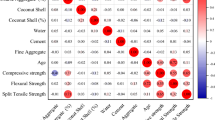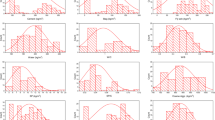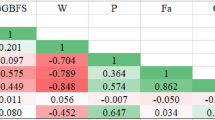Abstract
This present study focuses on forecasting the compressive strength (CS) of high-performance concrete (HPC), which is mixed with fly ash and slag, using machine learning techniques with hierarchical quadratic regression (HQ) and multiple linear regression (ML). The study is based on 528 experimental results collected from literature, with variables including cement, blast furnace slag, fly ash, water, super plasticizer, fine aggregate, and coarse aggregate. The primary objective of this study is to develop a model for predicting the CS of HPC. The proposed hierarchical equation outperforms the multiple linear regression model in terms of prediction accuracy. It achieves lower values for mean absolute error (MAE), mean squared error (MSE), root mean square error (RMSE), and mean absolute relative error (MARE), while attaining a higher coefficient of determination (with an R2 of 97.12%, adjusted R2 of 96.81%, and predicted R2 of 96.43%) compared to the ML model (which has an R2 of 91.56%, adjusted R2 of 91.4%, and predicted R2 of 91.17%). A sensitivity analysis was conducted to evaluate the impact of the independent variables on the CS. The results of sensitivity analysis prove that the content of cement significantly impacts the CS of HPC, with a sensitivity analysis parameter of approximately 30%. This is followed by BFS, fly ash, coarse aggregate, fine aggregate, water, and superplasticizer.








Similar content being viewed by others
Data availability
The data that support the findings of this study are available from the corresponding author, upon reasonable request.
References
Akhnoukh AK, Elia H (2019) Developing high performance concrete for precast/prestressed concrete industry. Case Stud Constr Mater 11:e00290. https://doi.org/10.1016/j.cscm.2019.e00290
Ali Ashrafian JB, Behnood A, Golafshani EM, Panahi E (2023) Toward presenting an ensemble meta-model for evaluation of pozzolanic mixtures incorporating industrial by-products. Struct Concr 25:1305–1323
Alzabeebee S, Al-Hamd RKS, Nassr A, Kareem M, Keawsawasvong S (2023) Multiscale soft computing-based model of shear strength of steel fibre-reinforced concrete beams. Innov Infrastruct Solut. https://doi.org/10.1007/s41062-022-01028-y
Ashrafian MJ, Panahi A, Salehi E, Taheri-Amiri S (2022a) On the implementation of the interpretable data-intelligence model for designing service life of structural concrete in a marine environment. Ocean Eng 256:111523
Ashrafian A, Hamzehkolaei NS, Dwijendra NKA, Yazdani M (2022b) An evolutionary neuro-fuzzy-based approach to estimate the compressive strength of eco-friendly concrete containing recycled construction wastes. Buildings. https://doi.org/10.3390/buildings12081280
Ashrafian PG, Panahi A, Salehi E, Karoglou S, Asteris M (2023) Mapping the strength of agro-ecological lightweight concrete containing oil palm by-product using artificial intelligence techniques. Structures 48:1209–1229
Aziminezhad M, Mahdikhani M, Memarpour MM (2018) RSM-based modeling and optimization of self-consolidating mortar to predict acceptable ranges of rheological properties. Constr Build Mater 189:1200–1213
Bertsimas D, Van Parys B (2020) Sparse hierarchical regression with polynomials. Mach Learn 109(5):973–997. https://doi.org/10.1007/s10994-020-05868-6
Bharatkumar BH, Narayanan R, Raghuprasad BK, Ramachandramurthy DS (2001) Mix proportioning of high performance concrete. Cem Concr Compos 23(1):71–80. https://doi.org/10.1016/S0958-9465(00)00071-8
Bui DK, Nguyen T, Chou JS, Nguyen-Xuan H, Ngo TD (2018) A modified firefly algorithm-artificial neural network expert system for predicting compressive and tensile strength of high-performance concrete. Constr Build Mater 180:320–333. https://doi.org/10.1016/j.conbuildmat.2018.05.201
Chen J, Chen J (2009) 12-1 Multiple linear regression models. pp 1–51
Cheng MY, Firdausi PM, Prayogo D (2014) High-performance concrete compressive strength prediction using genetic weighted pyramid operation tree (GWPOT). Eng Appl Artif Intell 29:104–113. https://doi.org/10.1016/j.engappai.2013.11.014
De Larrard F, Sedran T (2002) Mixture-proportioning of high-performance concrete. Cement Concr Res 32(11):1699–1704. https://doi.org/10.1016/S0008-8846(02)00861-X
Gandomi AH, Tabatabaei SM, Moradian MH, Radfar A, Alavi AH (2011) A new prediction model for the load capacity of castellated steel beams. J Constr Steel Res 67(7):1096–1105. https://doi.org/10.1016/j.jcsr.2011.01.014
Gandomi AH, Mohammadzadeh DS, Pérez-Ordóñez JL, Alavi AH (2014) Linear genetic programming for shear strength prediction of reinforced concrete beams without stirrups. Appl Soft Comput J. 19:112–120. https://doi.org/10.1016/j.asoc.2014.02.007
Hameed MM, AlOmar MK, Baniya WJ, AlSaadi MA (2021) Incorporation of artificial neural network with principal component analysis and cross-validation technique to predict high-performance concrete compressive strength. Asian J Civ Eng 22(6):1019–1031. https://doi.org/10.1007/s42107-021-00362-3
Han H, Yu R, Li B, Zhang Y, Wang W, Chen X (2019) Multi-objective optimization of corrugated tube with loose-fit twisted tape using RSM and NSGA-II. Int J Heat Mass Transf 131:781–794
Harith IK (2023) Optimization of quaternary blended cement for eco-sustainable concrete mixes using response surface methodology. Arab J Sci Eng. https://doi.org/10.1007/s13369-023-08071-6
Harith IK, Hussein MJ, Hashim MS (2022) Optimization of the synergistic effect of micro silica and fly ash on the behavior of concrete using response surface method. Open Eng 12(1):923–932. https://doi.org/10.1515/eng-2022-0332
Harith IK, Hassan MS, Hasan SS, Majdi A (2023) Optimization of liquid nitrogen dosage to cool concrete made with hybrid blends of nanosilica and fly ash using response surface method. Innov Infrastruct Solut 8(5):1–15. https://doi.org/10.1007/s41062-023-01107-8
Harith IK, Nadir W, Salah MS, Majdi A (2024) Estimating the joint shear strength of exterior beam–column joints using artificial neural networks via experimental results. Innov Infrastruct Solut. https://doi.org/10.1007/s41062-023-01351-y
Hayes AF (2020) Multiple linear regression. Stat Methods Commun Sci. https://doi.org/10.4324/9781410613707-13
Huang Y (2019) Multiple linear regression (MLR) handouts, pp 1–39
Jain A, Varshney AK, Joshi UC (2001) Short-term water demand forecast modelling at IIT Kanpur using artificial neural networks. Water Resour Manag 15(5):299–321. https://doi.org/10.1023/A:1014415503476
Kaloop MR, Kumar D, Samui P, Hu JW, Kim D (2020) Compressive strength prediction of high-performance concrete using gradient tree boosting machine. Constr Build Mater 264:120198. https://doi.org/10.1016/j.conbuildmat.2020.120198
Kattoof I, Zainab H, Abbas H, Kareem M, Mohammed H (2024) Comparison of artificial neural network and hierarchical regression in prediction compressive strength of self—compacting concrete with fly ash. Innov Infrastruct Solut. https://doi.org/10.1007/s41062-024-01367-y
Kiani B, Gandomi AH, Sajedi S, Liang RY (2016) New formulation of compressive strength of preformed-foam cellular concrete: an evolutionary approach. J Mater Civ Eng. https://doi.org/10.1061/(asce)mt.1943-5533.0001602
Kim H-Y (2019) Statistical notes for clinical researchers: simple linear regression 3—residual analysis. Restor Dent Endod 44(1):1–8. https://doi.org/10.5395/rde.2019.44.e11
Kosmatka ML, Wilson SH (2011) Design and control of concrete mixtures—the guide to applications, methods and materials
Law M, Jackson D (2017) Residual plots for linear regression models with censored outcome data: a refined method for visualizing residual uncertainty. Commun Stat Simul Comput 46(4):3159–3171. https://doi.org/10.1080/03610918.2015.1076470
Mousavi SM, Aminian P, Gandomi AH, Alavi AH, Bolandi H (2012) A new predictive model for compressive strength of HPC using gene expression programming. Adv Eng Softw 45(1):105–114. https://doi.org/10.1016/j.advengsoft.2011.09.014
Nadir W, Harith IK, Ali AY (2022) Optimization of ultra-high-performance concrete properties cured with ponding water. Int J Sustain Build Technol Urban Dev 13(4):454–471. https://doi.org/10.22712/susb.20220033
Neville AM (2005) Properties of concrete, 4th edn. Pearson Education Limited
Nguyen T, Kashani A, Ngo T, Bordas S (2019) Deep neural network with high-order neuron for the prediction of foamed concrete strength. Comput Civ Infrastruct Eng 34(4):316–332. https://doi.org/10.1111/mice.12422
Onyelowe KC, Ebid AM (2023) The influence of fly ash and blast furnace slag on the compressive strength of high-performance concrete (HPC) for sustainable structures. Asian J Civ Eng. https://doi.org/10.1007/s42107-023-00817-9
Padmini D, Ilamparuthi K, Sudheer KP (2008) Ultimate bearing capacity prediction of shallow foundations on cohesionless soils using neurofuzzy models. Comput Geotech 35(1):33–46. https://doi.org/10.1016/j.compgeo.2007.03.001
Peixoto JL (1987) Hierarchical variable selection in polynomial regression models. Am Stat 41(4):311–313. https://doi.org/10.1080/00031305.1987.10475506
Pham A-D, Hoang N-D, Nguyen Q-T (2016) Predicting compressive strength of high-performance concrete using metaheuristic-optimized least squares support vector regression. J Comput Civ Eng 30(3):1–4. https://doi.org/10.1061/(asce)cp.1943-5487.0000506
Qasrawi HY (2000) Concrete strength by combined nondestructive methods simply and reliably predicted. Cement Concr Res 30(5):739–746. https://doi.org/10.1016/S0008-8846(00)00226-X
Sandblom C-L (2019) 13. Multiple linear regression. Element Stat Bus Econ. https://doi.org/10.1515/9783110845693-014
Shalabh (2017) Multiple linear regression model the linear model. Regres Anal, pp 1–40
Smith GN (1986) Probability and statistics in civil engineering. In: Predicting shear wave velocity of rock-mass by fracture parameters. Collins, London, vol. 105
Sobolev K (2004) The development of a new method for the proportioning of high-performance concrete mixtures. Cement Concr Compos 26(7):901–907. https://doi.org/10.1016/j.cemconcomp.2003.09.002
Yeh IC, Lien LC (2009) Knowledge discovery of concrete material using genetic operation trees. Expert Syst Appl 36(3 part 2):5807–5812. https://doi.org/10.1016/j.eswa.2008.07.004
Author information
Authors and Affiliations
Contributions
Iman Kattoof Harith and Wissam Nadir wrote the main manuscript text and . All authors reviewed the manuscript. Mustafa S. Salah & Mohammed L. Hussien contribute in review editing and figures editing.
Corresponding author
Ethics declarations
Conflict of interest
The authors declare no competing interests.
Additional information
Publisher's Note
Springer Nature remains neutral with regard to jurisdictional claims in published maps and institutional affiliations.
Rights and permissions
Springer Nature or its licensor (e.g. a society or other partner) holds exclusive rights to this article under a publishing agreement with the author(s) or other rightsholder(s); author self-archiving of the accepted manuscript version of this article is solely governed by the terms of such publishing agreement and applicable law.
About this article
Cite this article
Harith, I.K., Nadir, W., Salah, M.S. et al. Prediction of high-performance concrete strength using machine learning with hierarchical regression. Multiscale and Multidiscip. Model. Exp. and Des. (2024). https://doi.org/10.1007/s41939-024-00467-7
Received:
Accepted:
Published:
DOI: https://doi.org/10.1007/s41939-024-00467-7




